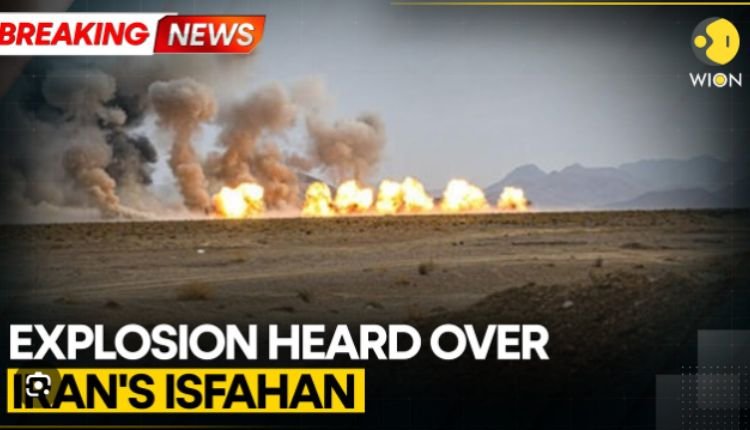The sound of explosions at an Iranian facility reverberated across the Middle East and forced airlines to divert flights. But the cause remains unclear. What’s clear is that an industrial shed at Natanz — the focus of Iran’s uranium enrichment work, which Tehran denies is for weaponization — has been damaged by what experts say was sabotage.
1. Isfahan
Isfahan, which translates as Half the World, is known for its palaces, tiled mosques and minarets. It’s also home to a number of Iran’s top attractions, including Naghsh-e Jahan Square, which has been listed as a world heritage site.
The square is surrounded by the Jame Abbasi Mosque, Lotfollah Mosque and Ali Qapu Palace, all of which are worth exploring. It’s also a popular place for locals to picnic on Friday and holidays. The Zayanderud River runs through Isfahan, and the city is famous for its historic bridges such as Si-o-Se Pol and Khaju Bridge.
Hamish de Bretton-Gordon, a UK-based nuclear expert, says the strike was likely aimed at Isfahan’s military infrastructure. He says it’s a “target rich environment” with an airbase and missile factory nearby. The location is also close to the بهترین سایت انفجار ایرانی where Iran is suspected of producing uranium that can be used to produce nuclear weapons. It’s a region already rife with tensions.
2. Tabriz
The city of Tabriz is a hub for Iranian culture and society. It hosts famous museums, major cultural events, and prestigious universities. It also offers a variety of outdoor activities. Besides that, it is home to breathtaking scenery and top-notch cuisine. One of the best places to visit in Tabriz is the Arg-e Alishah (Alisha Citadel). This massive brick edifice off Imam Khomeini St was once part of the old town’s early-14th-century citadel. It houses a museum with old maps and different objects.
Another must-visit place is the mausoleum of poet Ostad Shahriyar, better known as Shahriar. This mausoleum houses the tombs of a number of classical and contemporary Iranian poets, mystics, and notable personalities.
Moreover, the Rahli Bazar is a good place to buy fresh fruits and vegetables. You can also get a variety of other products from local shops in the city center. There are also small vendors that sell produce from the back of their trucks at cheaper prices.
3. Qazvin
Qazvin is one of Iran’s 31 provinces that boasts the highest number of registered heritage sites. As the cradle of calligraphy in Iran, this provincial capital is an ancient treasure trove for history enthusiasts.
The city’s regal past is visible in its edifices such as the Chehel Sotoon Palace, Grand Mosque, and Qajar Bathhouse. It is also home to a wide variety of natural and cultural attractions like the Shemiran Castle, the Sepid Rood Lake, Qala Kurd Cave, and the Safavid Garden Complex.
The tombs of two Saljuk era princes, Abu Saeed Bijar son of Sad and Aboo Mansur Iltai son of Takin, are found in two separate towers that are known as the Kharaghan twin towers. The towers were built in 1067 and were the first monuments in Islamic architecture to include a non-conic, two-layered dome. These structures were severely damaged by the 2003 earthquake. The tomb of Hamdollah Mostowfi, a famous geographer from the Mostowfian dynasty, is another notable attraction.
4. Shiraz
The capital of Fars province, Shiraz (pronounced Shee-rzh) is a city of gardens and poets. Its streets and structures are like time capsules, telling stories that have been echoed for millennia. Walk around and you’ll feel as if you’ve stepped into a history book.
One of the best things to do in Shiraz is visit Eram Garden, a cool old place that’s home to flowers and lots of other neat things that look like art. From there, head to Nasir al-Mulk Mosque, where you’ll be greeted by a rainbow of colors that will have you feeling like you’re walking into a dream.
It’s impossible to mention Shiraz without thinking about a certain 14th-century Persian poet named Hafiz. Considered the Shakespeare of Iran, he was master of the ghazal, a short, amorous, rhyming poem. He’s remembered at the Tomb of Hafez, a place where visitors often find themselves sitting in a garden, sipping wine from a clay cup, and reciting his verses to the music of an acoustic guitar.
Conclusion
Sometimes what a government says about a military strike is just as important as the strike itself. Iranian state media said air defense batteries fired Friday morning at a base near Isfahan, which is home to Iran’s nuclear and military sites. The sounds of explosions were heard, and airlines began advising their customers to avoid the area.


Comments are closed.